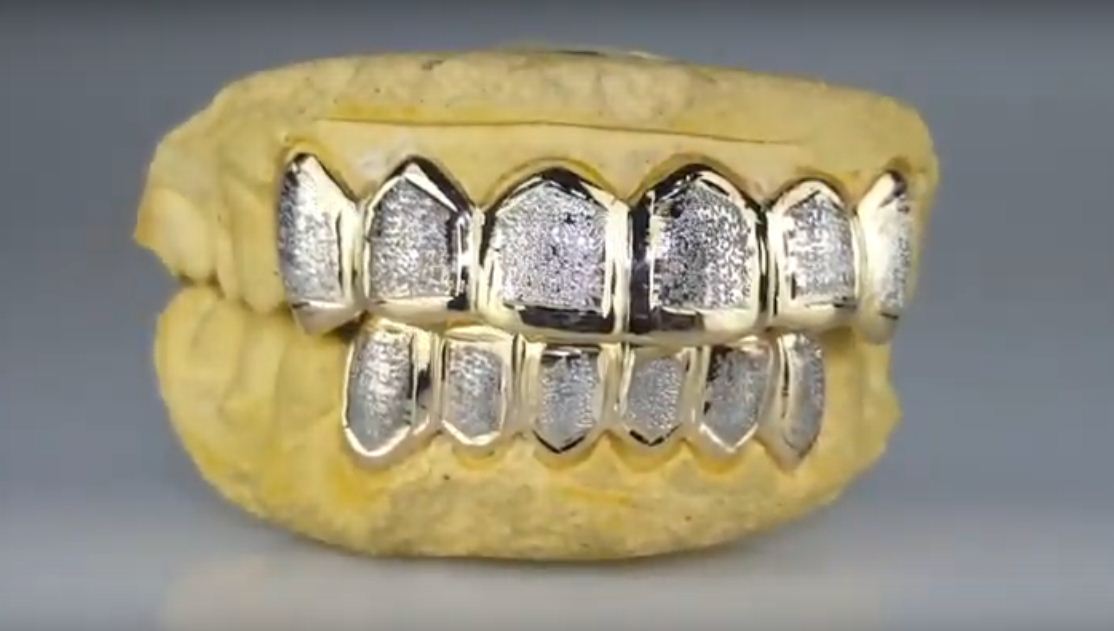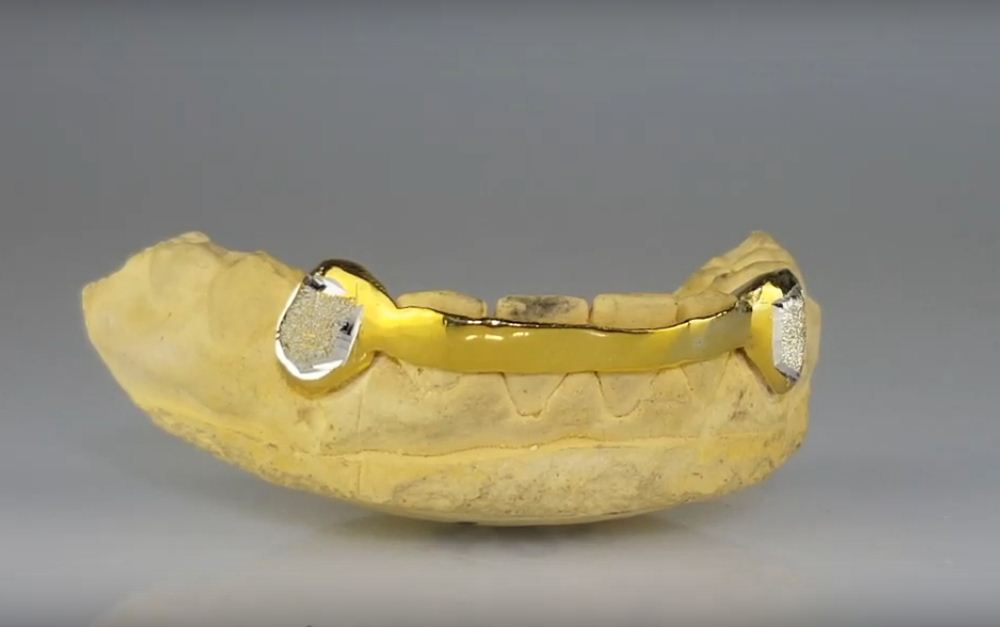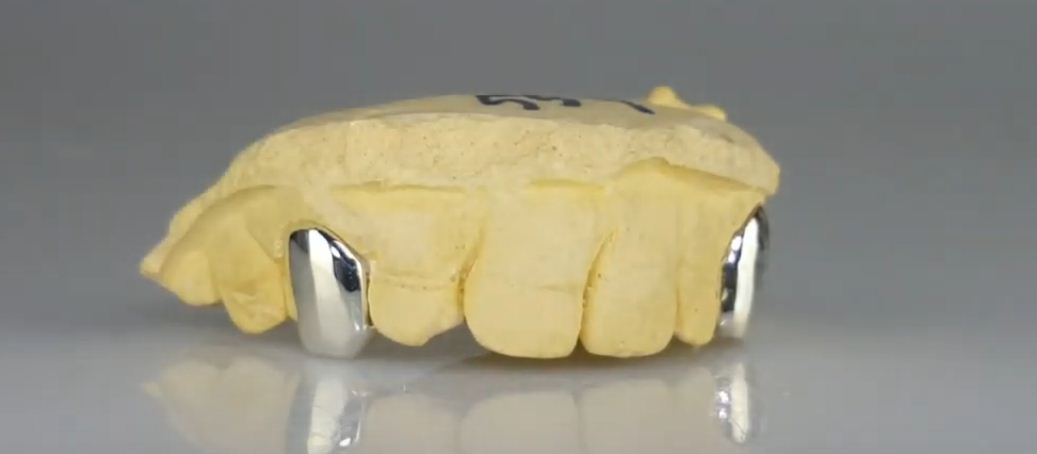Advantages of Invisalign Compared to Regular Braces
I've always wondered how I can have my teeth aligned without being forced to wear those ugly braces I see on kids and teens. Advancements in technology help a lot in developing new products to fit everybody's needs. In recent years, Align Technology has developed Invisalign - a series of transparent, removable aligners that orthodontists recommend as an alternative to regular braces.

Are you planning Langley orthodontics treatment, but are wondering what treatment is best for you? You've read all about the incredible benefits of Invisalign, but is it for you? What about regular braces - do they have added benefits Invisalign can't offer?
Salient advantages of Invisalign compared to regular braces
Invisalign is a set of custom-designed, clear, removable aligners that you wear in your mouth like a retainer. The aligners are exchanged for a new set every two weeks, and you wear them all day, except when eating and brushing and flossing. Treatment is similar to that of standard braces.
Regular braces, also known as ceramic braces, are made to either be transparent or colored to match the shade of your teeth. This ensures the brackets blend in with your teeth. Treatment is identical to that with standard metal braces, using brackets that are bonded to the teeth and connect with an archwire. This then puts pressure on your teeth to guide them to their ideal locations.
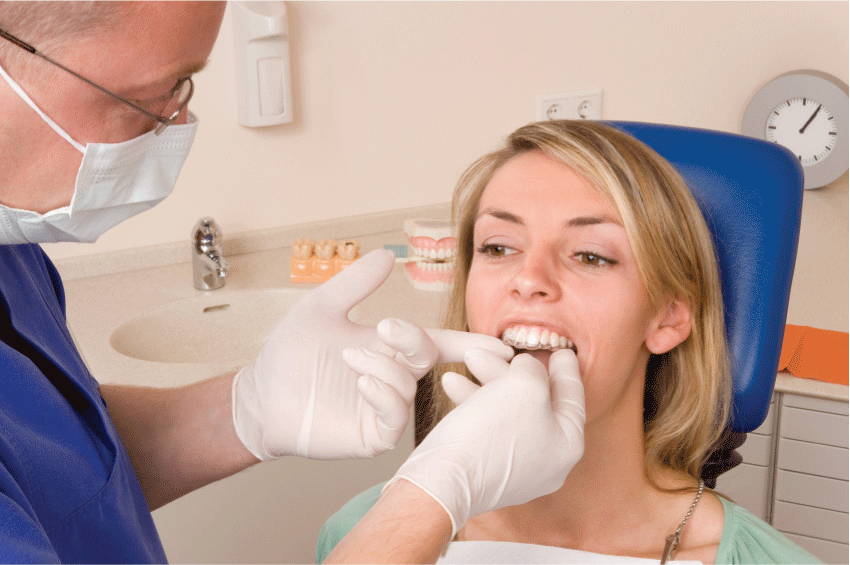
The biggest advantages of Invisalign to regular braces are that they offer a lower profile for patients who want to discretely straighten their teeth. This is especially true for adult patients, who often don't want to look like a teenager with a mouth full of metal. But there are several differences between the two.
Invisalign is almost completely invisible to others. The aligners are transparent, making them hard for others to notice. Regular braces can blend in with your teeth, but the brackets will still be noticeable.
Invisalign aligners are removable. This is perhaps the greatest advantage compared to the regular aligners. There is no need to alter your diet or oral care regiment. With ceramic braces, keeping your teeth clean can be harder, and you'll need to avoid certain foods to avoid harming the brackets.
Invisalign takes discipline - each set of aligners is worn for two weeks for a minimum of 22 hours a day. To have the best results, it is up to the patient to wear them as directed by their orthodontist. Regular braces simply require a visit to your orthodontist every four weeks for an adjustment.
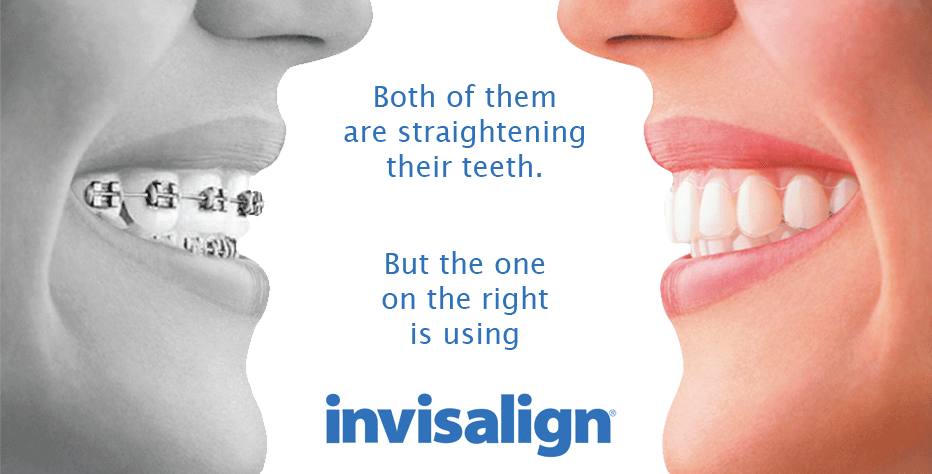
Regular braces can treat more extensive cases than Invisalign. While Invisalign technology has vastly improved and is able to treat more cases than when first introduced, braces are still the best for the most severe cased of crowding, and for instances of gaps, overbites, underbites and open bites.
Regular braces can be susceptible to chipping and breaking because they tend to be a little bit brittle. Additionally, it can take patients a while to get used to the feeling of the brackets and wires in their mouths. They can cause some irritation to the lips and cheeks, especially in the first few days after they've been put on.
On the other hand, Invisalign is made of a smooth plastic that fits comfortably in the mouth, and utilizes a gentle pressure to move the teeth to their ideal locations.
Invisalign and regular braces are both wonderful options for straightening the teeth in a more aesthetically pleasing way. If you are interested in perfecting your smile inconspicuously, it's important to schedule a consultation with an orthodontist to determine which type of treatment is best for you.
Braces vs Invisalign > From an Orthodontist That Uses Both
Updated by : Admin, Date: 26-April-2017
Having problems with your teeth? Your Orthodontist would be glad to help you solve your problems. He knows how he can really help you improve your teeth. The orthodontist will give you these two options that can help straighten your teeth: the Invisalign and the Braces.
Invisalign was first used in 2000. This is specially designed to be invisible. The aligner trays used here are made of smooth, BPA-free clear plastic which is comfortable to use. The trays are placed over the teeth to be able to move your teeth gently. To be able to make an exact 3-D image of your teeth, the orthodontist uses x-rays, pictures, and impressions. The said procedures are also helping to arrange the aligner trays carefully.
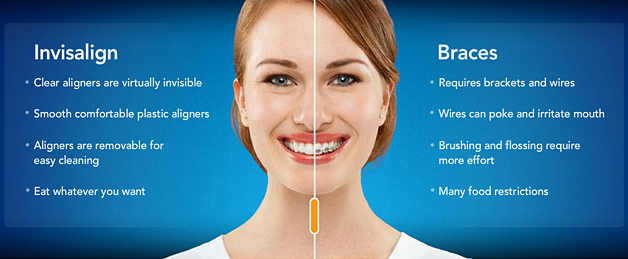
Invisalign is clear and invisible. Its treatment period covers 22 to 24 hours per day which will last for 1 ½ year or 18 months. The cost incurred for this treatment is $5,000. Cleaning the aligner is easy, all you have to do is just use Luke warm water. The aligner trays should be changed every 2 weeks. Another good thing in using the aligner trays is that it will not give you difficulty eating.
After considering the pros, Invisalign has also some disadvantages that can make you uncomfortable. Some of these issues include the necessity to remove it before eating and drinking. It should also be brushed and cleaned after eating.
Braces are made up of metal brackets which are glued to the teeth. It is tied together using wires and tiny rubber bands. The Braces can make you more stylish because you can have the color that you want.
The treatment period for this treatment is two years, however, it will also depend on your needs or other patient needs. The average cost of $1,800 to $5,500 is a bit higher compared to the Invisalign. For its proper maintenance, you have to regularly brush the brackets and wires while you brush your teeth.

Looking into the different features offered by braces and Invisalign, you can always consider the comfort brought about using the brace and the Invisalign. For instance, it would be inconvenient for you to remove your aligner trays every time you eat or drink. You also have to brush the trays after every meal. These, of course, will be tedious, especially if you’re dining out with friends and colleagues.
If you opt for braces, you will be incurring a higher cost, but, if you consider some of the cons or disadvantages in using the aligner, you would probably choose to use the brace. You’ll find the brace more comfortable to use.
Having straight teeth can improve your overall appearance. It will also help you gain more confidence because it can reflect that you are indeed healthy, inside and out. It is, therefore, important to take care of your teeth. Never take for granted whatever issues that has something to do with your teeth. Healthy teeth can bring out the best in you!
How long to eat soft diet after tooth extraction?
Teeth removal and recovery can take up to a week, depending on your specific case. Recovery may take longer if your wisdom teeth are impacted. This means that they haven’t emerged from below the gums yet and aren’t visible.
Food that will be easy to eat without much chewing, and food that won’t disrupt your blood clot or stitches.
Start with very soft food at first, such as:
- cottage cheese
- apple sauce
- pudding
- soup
- mashed potatoes
- smoothies

Several types of foods can irritate the wounds in your mouth as they’re healing after surgery.
Here are some foods to avoid after wisdom tooth removal.
- Spicy foods: May cause pain and irritation.
- Crunchy and crumbly foods: Foods like chips and cookies may get lodged in the wound area and disrupt healing.
- Most grains and seeds: Can also get lodged in the wound and disrupt healing.
- Chewy foods: Can increase your risk of biting your cheek, lips and tongue, especially soon after the surgery while your senses are still numb.
- Alcohol: Avoid alcohol during the recovery period after wisdom tooth removal. It may irritate the wound or interact with any prescribed medication.
- It’s also important to avoid using a straw while you recover from wisdom tooth removal. Straws create suction in the mouth that increases the risk of developing a dry socket. A dry socket is a painful condition in which the clot that was protecting the area where the tooth was removed becomes dislodged. As a result, the underlying bones and nerves are exposed to air, which causes pain and delays healing
How much are teeth grillz?
It depends on many factors, but if you’re looking for an affordable option, our start at $19.99 and go up to $59.99. If you’re looking for a custom set that is made of solid gold, you’re looking at anywhere from $200 to $1,800 and up.
The variance in the pricing because of materials and complexity. The more exotic the materials, the more expensive the grill, the more complex the designs are, the longer and more expensive the process becomes. The most expensive grill made for example, is worth $152,700 due to the 24 carat pure gold and 160 diamonds. The Dubai dentist had the diamonds in the grillz verified by the World Diamond Institute for authenticity and clarity. If spending thousands is out of the question, we offer gold plated stainless steel grillz. These grills start at $19.99 and give you the look of a solid grill without breaking the bank.
Two most popular and well known item, the solid style grillz. These grillz are the most simple and timeless with their clean design and simple aesthetics. Our next most popular grillz are the iced out ones. Our premade CZ grillz look great without breaking the bank while our iced out custom fitted grillz are perfect for those looking for a solid 10k, 14k, or 18k iced out grill. These grillz are great for those looking to add some shine in their smile.
Solid style grillz are perfect for those who want a little shine in their mouth, but want to stick with something classic. These grillz look great with just about any outfit and are a great accessory. If you’re on a budget, our premade grillz are a good choice due to their shine for the price. You get real 18k gold plated over a stainless steel grill for a great looking grill that will last years. If you have the money to step up, to a custom fitted grill, we recommend that you do. Because it is made of solid 10k, 14k, or 18k gold, you can rest assured that the grill will never fade or tarnish.
Iced Out grillz are another customer favorite. Each grill features our AAA grade cubic zirconia stones for a great shine and clarity at a price that’s hard to beat. Our CZ grillz are some of our best selling products. Their look, durability and shine are perfect for drawing attention. Starting at $29.99, these are our most value orientated iced out grillz. They are plated with 18k real gold over a stainless steel core so they have the shine of a real grill and will last you for years. Want to upgrade to something that will last a lifetime? Check out our Custom fitted sets of grillz. We offer the option to ice them out just like our CZ grillz. The difference is instead of getting real gold plated over stainless steel, you get solid 10k, 14k or 18k gold grillz. As stated before, the solid grillz will last a lifetime as long as you care for them and clean them as you would other jewelry. Although the price is a lot more, we feel that having that piece of mind knowing the grillz will never let you down is worth it.
How much does it cost to fix a loose tooth
You can't tighten loose teeth at home,you have to get yourself to a dentist,he/she will determine the cause,get to a diagnosis and implement the right treatment,which may include splinting(bracing teeth with biocompatible materials),for a period of time.
There are a number of causes for teeth becoming loose,they have to be determined prior to treatment.
Extremely loose teeth usually cannot be saved.So, cost to Fix a loose tooth depends on right treatment.
Teeth that have become loose because of lost gum tissue can benefit from a new technique called dental splinting which attaches weak teeth together, turning them into a single unit that is stable and stronger than the single teeth by themselves. The procedure is most commonly performed on the front teeth.
The procedure is as simple as using composite material to attach, or splint, the loose teeth to the adjoining stable teeth. Tooth splinting is a common procedure that has gained popularity due to its effectiveness.
In dental splinting, teeth are joined together using a thin fibre reinforced wire thereby increasing their stability. This is a factor which allows them to function normally. This procedure is beneficial because it allows you to save your teeth. Additionally, splinting also reduces the pain that a very mobile tooth can cause. Mobile lower anterior teeth are a common complaint of dental patients with fairly advanced periodontal disease.
Treatment of these mobile teeth is often not very successful. The mobility is caused by a loss of supporting bone around the roots of the teeth. Even comprehensive periodontal treatment cannot replace this missing bone and the prognosis for these teeth is poor.
The most logical way to treat the mobility once the active periodontal disease is under control would be to splint these mobile teeth. Various methods of splinting are employed by our Cosmetic dentists at Lane Ends DEntal Practice in Preston. The most frequently used technique is to use orthodontic stainless steel wire, bonded on to the inside surface of the teeth with composite which acts as a splint.
This method has some success but the metal wire is quite rigid, and this type of splint tends to come loose and fail in time. Another disadvantage of this technique is that there is no true bonding between the metal wire and the composite filling material. There can also be aesthetic compromises with this technique, but the concept is good and these splints are an option if nothing better is available.
How much does it cost to replace a filling?
The average cost of amalgam or silver re-filling per tooth is between $65 on the low end and $200 on the high end. On the other hand, composite resin re-filling (teeth-color) costs $125 to $250.
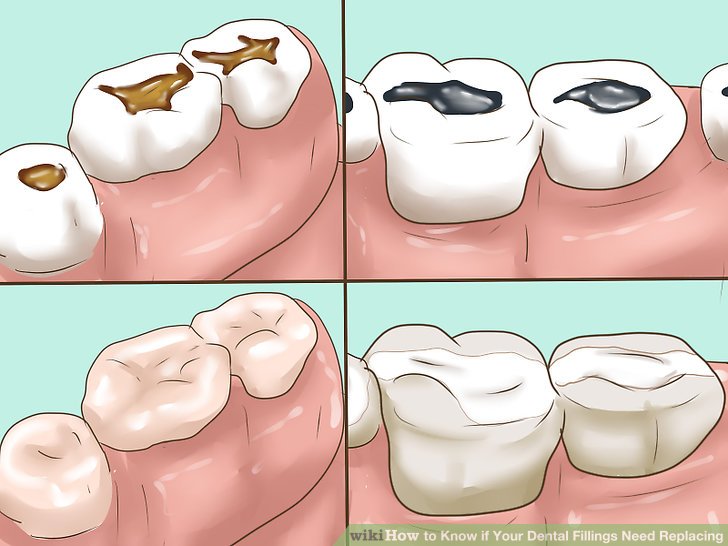
Your dentist will try to repair the old filling before placing it back in the tooth cavity instead of replacing it completely. However, if the entire filling has to be replaced because the old filling proves to be beyond repair, the dentist will re-assess and discuss what filling material to use.
It's also important to maintain good dental hygiene on a daily basis. This will prevent future problems arising from poor dental care. Brush and floss your teeth regularly and don't neglect dental check-ups once your lost filling has been repaired or tooth cavity has been refilled.
Permanent fillings become loose and fall out for many reasons. First, it may be loosened when your teeth go through a great deal of pressure when you chew. Second, the bonding of the filling may loosen due to saliva that gets into the cavity and gradually reacts with the filling. Third, a filling might fall out because of newly developed decay in the area surrounding it. Finally, biting hard food can loosen of the filling. A filling falling results in exposure of the interior surface of your teeth to bacteria and food particles. This leads to gradual decay and sensitive teeth
It's important to know what to do when your tooth filling falls out:
• Keep the filling so the dentist can determine if it should be used after it's been cleaned, or if it should be replaced.
• Gently brush the teeth around the affected tooth and clean your mouth and teeth by rinsing with water or mouth wash.
• Numb your gums and tooth with oil of clove by rubbing it gently where the filling has come out. This helps to alleviate any discomfort.
• Mold dental wax into the tooth so it temporarily fills the void.
• If pain persists, take medication such as Tylenol and ibuprofen to help lessen the pain. Follow the instructions closely for proper usage prior to seeing your dentist.
How much for dental implants
The cost of dental implants tends to compare very favorably to other tooth replacment options because dental implants can last so long, even an entire lifetime. Importantly, you will want to use an experienced, credentialed implant dentist so your implants last and look good. Other teeth replacement options may appear to have a lower up front cost, but you will continue to pay that cost over and over, making them expensive compared to dental implants.
The cost for a dental implant to replace a single tooth is estimated to be in the range of $3,000 to $4,500, according to The New York Times. However, the key for you to get the lowest possible cost is to check with a credentialed dental implant expert.
Dental implants can be used to replace a single tooth, several teeth, or all of the teeth. The goal of teeth replacement in dentistry is to restore function as well as esthetics.
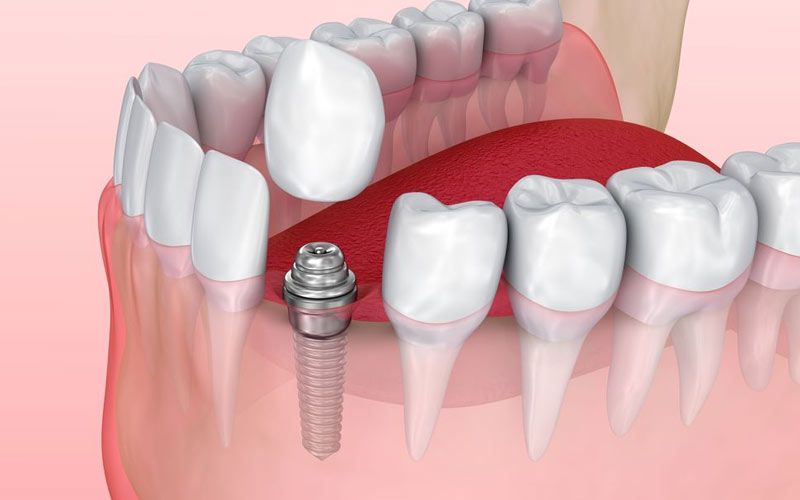
When it comes to tooth replacement, generally, there are three options: (1) removable dental appliance (complete denture or partial denture), (2) fixed dental bridge (cemented), and (3) dental implant. Dentures are the more affordable option for replacement teeth but are the least desirable because of the inconvenience of a removable appliance in the mouth. Furthermore, dentures can affect one's taste and sensory experience with food. Dental bridgework was the more common restorative option prior to the relatively recent shift to dental implant treatment. The main disadvantage to bridgework is the dependence on existing natural teeth for support. Implants are supported by bone only and do not affect surrounding natural teeth. Deciding on which option to choose depends on many factors. Specifically for dental implants, these factors include
location of missing tooth or teeth,
quantity and quality of the jawbone where the dental implant is to be placed,
health of the patient,
cost, and
patient preference.
A dental surgeon examines the area to be considered for the dental implant and makes a clinical assessment of whether the patient is a good candidate for a dental implant.
There are great advantages to choosing a dental implant for tooth replacement over the other options. Dental implants are conservative in that missing teeth can be replaced without affecting or altering the adjacent teeth. Furthermore, because dental implants integrate into the bone structure, they are very stable and can have the look and feel of one's own natural teeth.
How much it costs to pull a tooth?
The cost for tooth extraction varies widely depending on whether the tooth is impacted. Simple extraction usually costs between $75 and $200 per tooth, and may be more depending on the type of anesthesia you need.
The cost to remove impacted teeth is significantly higher and can land anywhere between $800 and $4,000. Where you live can also impact how much you pay for the procedure, as many services are tailored to an area’s cost of living.
Your tooth extraction will either be simple or surgical, depending on whether your tooth is visible or impacted.
Simple extraction
You will receive a local anesthetic, which numbs the area around your tooth so you’ll feel only pressure, not pain, during the procedure. The dentist then uses an instrument called an elevator to loosen the tooth and forceps to remove it.
Surgical extraction
You will likely receive both local anesthesia and intravenous anesthesia, the latter of which makes you calm and relaxed. You may also receive general anesthesia, depending on any medical conditions. With general anesthesia, you will remain unconscious during the procedure.
The general dentist or oral surgeon will cut into your gum with a small incision. They may need to remove bone around your tooth or cut your tooth before it can be extracted.
There are a few risks for undergoing a tooth extraction; however, if your dentist recommends the procedure, the benefits likely outweigh the small chance of complications.
Usually after a tooth extraction, a blood clot naturally forms in the socket — the hole in the bone where the tooth has been extracted. However, if the blood clot does not form or dislodges, the bone inside the socket can be exposed — referred to as “dry socket.” If this happens, the dentist will protect the area by putting a sedative dressing over it for a few days. During this time, a new clot will form.
Other risks include:
- bleeding that lasts longer than 12 hours
- severe fever and chills, signaling an infection
- nausea or vomiting
- cough
- chest pain and shortness of breath
- swelling and redness at the surgical site
- Contact your dentist if you experience any of these symptoms
How to take the glue off of your teeth
After a visit with the orthodontist, some teeth may still have some glue residue. This glue was what held the braces onto the teeth. The orthodontist or dentist can usually help get most of it off of your teeth, but there may be some left behind that you can remove at home.
- Create a paste to brush your teeth with. Start with 2 tsp. baking soda and slowly add 1/2 tsp. of peroxide. Bubbling is normal.
- Dip the electric toothbrush's bristles into the paste before turning the toothbrush on.
- Brush your teeth over those with glue residue for two to three minutes. This will help soften the glue residue. It is OK to brush your other teeth since this mixture can help whiten teeth as well.
- Gently scrape the glue residue with the dental pick. Be extremely careful to not scrape off enamel during this process. All of the glue may not come off at first. Repeat if necessary to get rid of all the glue.
- Floss between teeth if there is glue crossing the space between teeth.
- Rinse your mouth out well to get rid of any of the glue that came off when picking and flossing. Repeat if necessary. It may take a few tries to get all the glue off. If there is still glue stuck to your teeth after several tries, consider calling your dentist to set up an appointment.
What is a dental bone graft
Bone grafting is a minor surgical procedure that is normally done in a dental office. An incision is made in your gum to gain access to the bone beneath it, and then grafting material is added. Most often, the grafting material is processed bone minerals around which your body will actually deposit new bone cells.
The grafting material itself can come from your own body, but very often it is bone from an animal or human donor that has been treated by a laboratory to make it sterile and safe. It can even be a synthetic substance. Grafting material comes in a variety of forms: powder, granules, putty or a gel that can be injected through a syringe. The graft, which is generally covered by a collagen membrane for optimum bone repair, will act as a scaffold onto which your body will build new bone.
Uses for Bone Grafts
Bone grafting for dental implants.
Bone grafts are used in dentistry to accomplish the following treatment goals:
Saving Teeth — When severe periodontal disease causes bone loss, teeth can become loose and at risk of being lost. In order to save them, the bone around them can be regenerated through grafting; this increases bone support and helps keep them in place.
Tooth Extractions — These days, it is very common to deposit bone grafting material into a tooth socket after a tooth has been removed. That way, should you want to replace your tooth with a dental implant later on, that option will be available.
Dental Implants — In this optimal tooth-replacement system, a small titanium post embedded in the jawbone is attached to a highly realistic dental crown, permanently replacing the missing tooth. Implants require good bone volume and density to achieve their excellent functionality and high success rates. If you have already experienced bone loss, a graft can help regenerate enough bone to place the implant successfully.
What is dental plaque
Plaque is a sticky, colorless film of bacteria and sugars that constantly forms on our teeth. It is the main cause of cavities and gum disease and can harden into tartar if not removed daily.
Everyone develops plaque because bacteria are constantly forming in our mouths. These bacteria use ingredients found in our diet and saliva to grow. Plaque causes cavities when the acids from plaque attack teeth after eating. With repeated acid attacks, the tooth enamel can break down and a cavity may form. Plaque that is not removed can also irritate the gums around your teeth, leading to gingivitis (red, swollen, bleeding gums), periodontal disease and tooth loss.
It's easy to prevent plaque buildup with proper care. Make sure to:
Brush thoroughly at least twice a day to remove plaque from all surfaces of your teeth
Floss daily to remove plaque from between your teeth and under your gum line, where your toothbrush may not reach
Limit sugary or starchy foods, especially sticky snacks
Schedule regular dental visits for professional cleanings and dental examinations
Scaling
During scaling, plaque and tartar are removed from the crown and root of the tooth.
What is the best electric toothbrush recommended by dentists
Dentist Recommended Toothbrushes
1. Oral-B Black Pro 1000 Power Rechargeable Electric Toothbrush
2. Waterpik Complete Care Water Flosser and Sonic Toothbrush
3. Philips Sonicare DiamondClean Sonic Electric Rechargeable Toothbrush
4. Philips Sonicare 2 Series Plaque Control Sonic Electric Rechargeable Toothbrush
5. Oral-B Pro 7000 SmartSeries White Electronic Power Rechargeable Battery Electric Toothbrush with Bluetooth Connectivity
6. Oral-B Pro 5000 SmartSeries Power Rechargeable Electric Toothbrush with Bluetooth Connectivity
7. Oral-B Vitality Floss Action Rechargeable Electric Toothbrush
8. Philips Sonicare Essence Sonic Electric Rechargeable Toothbrush
9. iBrush SonicWave Electric Toothbrush with UV Sanitizer
10. Sterline Sonic Electric Rechargeable Toothbrush and Holder
What is the best teeth whitening pen
Whitening pens work in the same way as many bleaching products. They use a bleach which seeps into the tooth and breaks up color compounds, making the teeth appear white. This means that the most effective whitening pens not only remove surface stains, but can whiten the tooth beyond its natural color.
While there are some differences, most whitening pens operate in a similar way. Simply:
a.Twist the pen to release the gel into the tip
b.Paint the whitening gel onto the teeth surface
c.Wait the designated time before eating or drinking.
Teeth Whitening Pen List
1.Colgate Whitening Pen and Toothbrush
2.Auraglow Teeth Whitening Pen
3.Philips ZOOM! Whitening Pen
4.Dazzling White Instant Whitening Pen
5.Smilebriter Whitening Pen
6.Dentapro Professional Teeth Whitening Pen
7.Smileactives Teeth Whitening Pen
8.Go Smile On The Go Whitening Pen
What to eat when you get a tooth pulled
Eat Ice Cream
Unless you have particularly sensitive teeth, ice cream tops of the list of what to eat after tooth extraction, especially in the summer. It's cool and soft, so you can eat it comfortably even when your mouth is tender. Because ice cream is cold, it can help minimize any natural swelling that occurs in the mouth.
Choose your ice cream with care, though. Soft serve is ideal right after surgery, since it doesn't require as much jaw muscle to eat. You'll also want to avoid any mix-ins or solid sprinkles along the top of the ice cream. Remember to pick a cup over a cone, too.
Cool Soup
Pureed, lukewarm or cool soups are also great to eat after a tooth's removal. It is summertime, however, so you might prefer a smooth gazpacho over a bowl of lukewarm broth. Soup is not only easy to eat after your surgery, but it also contains plenty of nutrients and, in some cases, protein, to help the muscles in your face feel better. To avoid any discomfort, make sure the soup is as smooth as possible before you eat it. A few small pieces of cooked vegetables or pasta in the soup should be manageable, but you want to avoid anything that will require a lot of chewing.
Smoothies
Fresh fruits tend to be at their peak in the summer. One of the best ways to enjoy them after you've had a tooth pulled is in smoothie form. Blend the fruits with some yogurt or kefir to add protein, calcium and probiotics to the drink. Adding yogurt or a similar type of dairy to the smoothie also helps it become less acidic, and less likely to irritate tender gums as a result.
Scrambled Eggs
As long as they aren't too hot, scrambled eggs are another good pick following a tooth extraction. They're gentle, high in protein and don't require much effort in the way of chewing when eating them.
Oatmeal
If you simply can't stomach another serving of eggs, instant oatmeal can be a good option for breakfast. Don't make steel-cut oats—they’re too tough to swallow whole. I’ve relied on this basic oatmeal recipe, and you can add in some soft fruit such as bananas or mashed blueberries.
Pudding, Frosting, and Sheet Cakes
You'll be happy to hear that a whole bunch of dessert can be on the menu when you're recovering—pudding slides down your throat effortlessly, so you'll probably want to load up on a 12-pack of Jello. But I'm also happy to report that a frosted cake or cupcake can be managed with a spoon and some patience. Enjoy your treat with a glass of cold milk and everything will wash down easily.
Who is the best dentist for implants
Primarily your family dentist, or general dentist, coordinates and provides the diagnosis for implant therapy. He or she often does the restoration of the implant that is surgically placed by the specialist whom he refers to for that procedure. A surgeon is a person that your general dentist usually works with and provides the impressions and other materials needed for the proper placement of the implant. Sometimes the general dentist would have acquired the extra training that is needed in order for them to be able to do the surgical placement of the implant. Remember that your general dentist' primary concern is your long term well-being.
One of the dental specialists that work with your general dentist, at times, for your implant therapy, could be a prosthodontist. They do an extra two years of training in the field of prosthetics. In other words the placement or crowns and bridges, removable dentures, and complete dentures. They usually would have to have an extra course of study in the surgical placement of the implants as the general dentist would.
Another dental specialist that does implant placement would be an oral surgeon. They do an extra four years in the study of surgical procedures that usually includes implants. This specialist can easily sedate their patients and often do more difficult implant procedures.
Another dental specialty that does a good job with implant placement is a periodontist. They receive extra training in the treatment of gum disease. Sometimes when patients get referred to them, they are a point where some tooth loss is inevitable. With their skill in surgical techniques, they are in a perfectly suited for implant placement. Of course in this situation, your dentist will have to restore the implant.
The final specialists that are emerging into implant placement are the endodontist. They go to a few years of extra training in order to treat teeth with endodontic therapy. They are, like all dentists, confronted with times when they lose teeth. With atraumatic extractions, they can usually place implants successfully. Of course, in this case, the dentist has to restore the implant.
Implants have no specialty requirements so most dentist that feel that are trained to place them, can. Let your regular dentist advice you. If he or she doesn't feel qualified to place the implant, they will be able to guide you.
How much does it cost to fix a chipped tooth
Although the cost of fixing a chipped or broken tooth varies from one dentist to another, it depends a lot on the amount of tooth structure you’ve lost and the type of damage. Also, consider how much your insurance is willing to pay and if your dentist is including other services in the cost—like exams, x-rays and temporary crowns. Don’t avoid going to a dentist you don’t have insurance. Many offices offer payment plans these days.
On average, a minor chip with a rough surface can sometimes be polished to make it smooth again for anywhere between $100 and $200, while fillings start at around $200. For teeth with no nerve or pulp damage, crowns range from $850 to $1,200, and any repair with pulp damage (you’ll know because the pain will be immense) will likely require a root canal followed by a crown that costs $1,500 to $2,000 and up.
How to get wisdom teeth swelling down in minutes
For wisdom teeth swelling caused or exacerbated by pieces of food lodged in the area, rinsing the mouth out with salt water or an oral rinse recommended by your dentist can remove trapped food and clean the area, allowing your body to reduce swelling and pain.
Other ways to reduce wisdom teeth swelling include cold compresses, ice chips, or ice packs applied to the area or to the face. Over-the-counter pain relievers that contain an anti-inflammatory will also help reduce wisdom teeth swelling, which can make eating, opening your jaw, talking, and everyday life much more comfortable.
Why Dental Oral Health Check-Up Is Important?
Normal health Check-up is significant on the grounds that they help keep your teeth and gums sound. You ought to have a standard dental visit somewhere around like clockwork or as prescribed by your dental expert. What occurs at your dental visit?
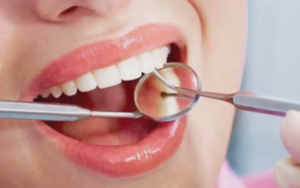
There are 2 sections to a normal dental visit – checkup, or assessment and the cleaning, or oral prophylaxis. At the dental check-up, your dental expert will check for pits. X- beams may be taken to identify cavities between your teeth. The test will likewise incorporate a check for plaque and tartar on your teeth. Plaque is a reasonable, sticky layer of microorganisms. In the event that it isn't evacuated, it can solidify and progress toward becoming tartar. You can't expel tartar with brushing and flossing. On the off chance that plaque and tartar develop on your teeth, they can cause oral illnesses.
Oral Cancer Detection
Oral Cancer is a very genuine malady that shows itself in different ways. Without knowing the indications of its initial beginning, oral the disease is regularly not analyzed and can rapidly advance and move toward becoming perilous. However, fortunately, a beginning period oral malignancy determination is regularly effectively treatable.
Plaque, Tartar, and Cavities
Indeed, even with the most industrious day by day brushers and flossers, there are still little regions in the mouth that are missed by a customary brushing and flossing. At the point when plaque develops it turns out to be increasingly hard to evacuate, hardening and transforming into tartar, which is amazingly hard to dispose of without expert assistance.
Gum Disease
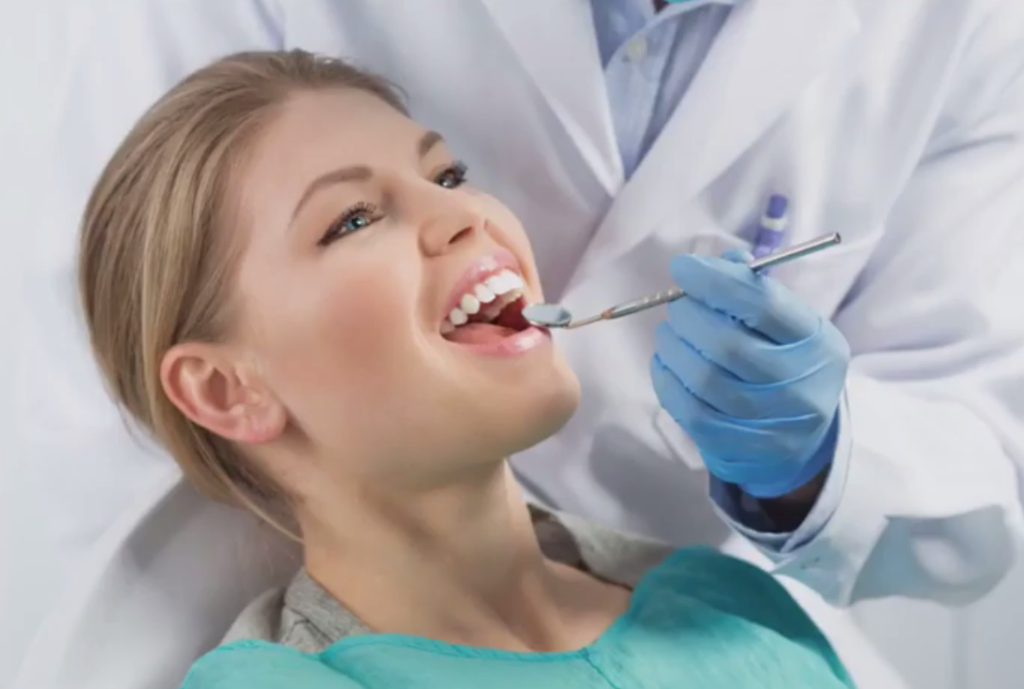
Plaque and tartar development cause tooth rot as well as disintegrate the mouth's gum tissues. This happens when tartar development causes contamination where the gum is associated with the tooth, making the gum pull away from the tooth. This contamination is referred to as gum disease and as it advances the tissue that connects gums to the teeth separates.
Holding Bad Habits in Check
There are numerous unfortunate propensities that have negative effect on your oral wellbeing, some of which you may not understand is causing issues. A portion of these propensities incorporates biting ice, gnawing your nails, gripping your jaw, pounding your teeth, eating especially sticky or hard desserts, brushing your teeth excessively hard, drinking espresso and red wine, and obviously smoking.
Discover Problems Under the Surface With X-Rays
A pivotal piece of visiting your dental specialist at regular intervals is getting your teeth and jaw bone x-rayed. X-beam pictures enable dental experts to perceive what's going on underneath the surfaces of your mouth and can discover and analyze issues that might be undetectable to the unaided eye. Issues like this can incorporate affected teeth, which are developing teeth that are hindered from pushing through the gum line, as frequently found in insight teeth.
Head, Neck, and Lymph Node Checks
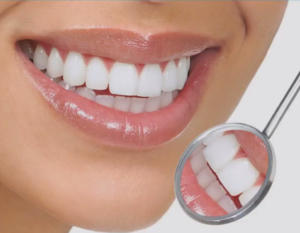 Notwithstanding checking your mouth, gums, and tongue for signs of oral malignant growth, your dental specialist will likewise check your neck, jaw, and lymph hubs, found just underneath your facial structure, for any swelling, irregularities, or different variations from the norm. On the off chance that an anomaly is discovered it could be an indication of a noteworthy medical the problem, and your dental specialist will alarm you to it and allude you the suitable medicinal expert.
Notwithstanding checking your mouth, gums, and tongue for signs of oral malignant growth, your dental specialist will likewise check your neck, jaw, and lymph hubs, found just underneath your facial structure, for any swelling, irregularities, or different variations from the norm. On the off chance that an anomaly is discovered it could be an indication of a noteworthy medical the problem, and your dental specialist will alarm you to it and allude you the suitable medicinal expert.



